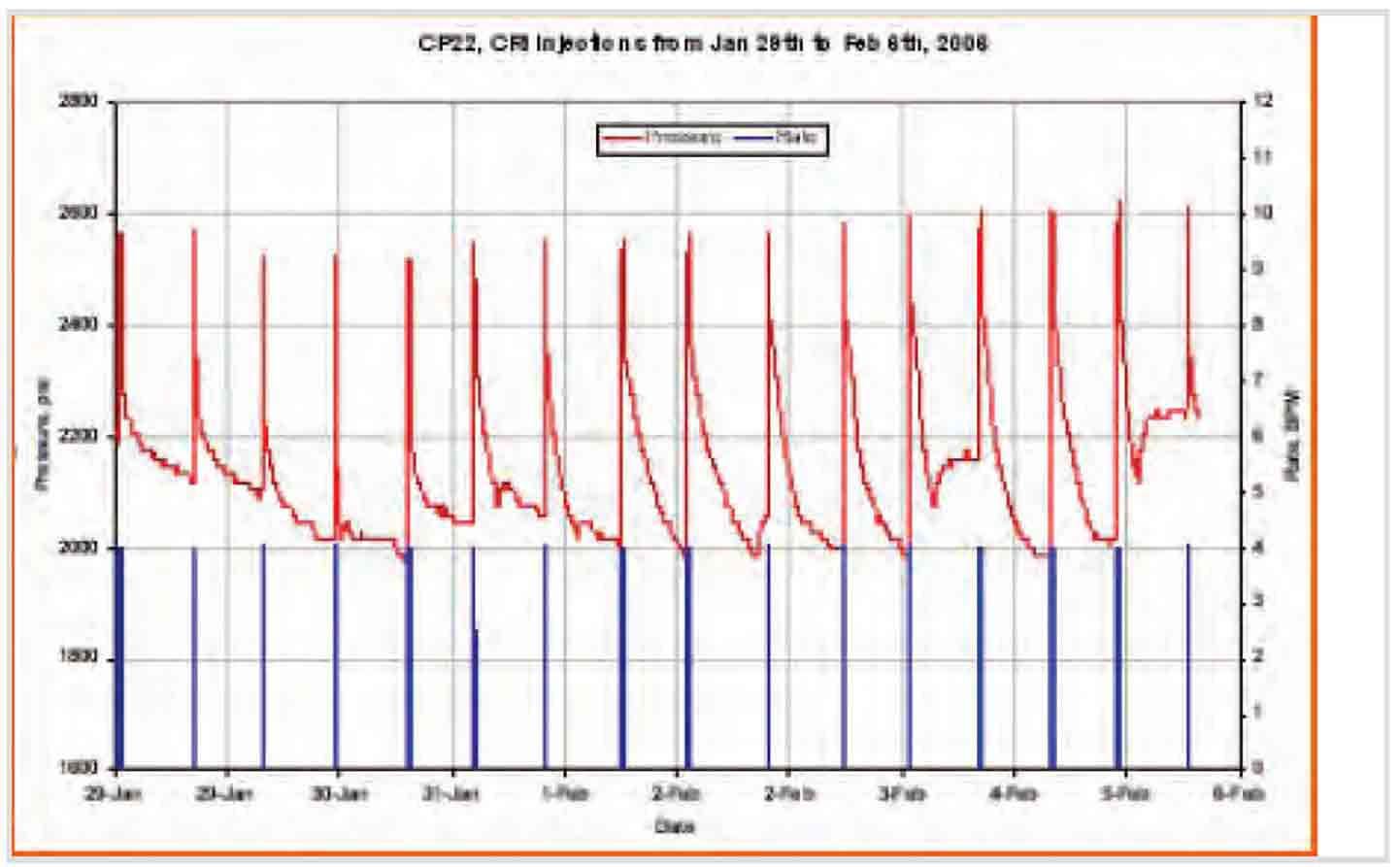CRI Technology Helps Meet Zero Discharge Policy and High Environmental Standards
Published: 01/01/2010

CRI Technology Helps Meet Zero Discharge Policy and High Environmental Standards
Published: 01/01/2010

The Situation
In the third quarter of 2004, BP decided that for reservoir development reasons, it was necessary to first drill a number of advanced appraisal/development production wells on the Clair Field before the bottomhole location of the first injection well and primary CRI well could be confirmed. To comply with BP’s environmental commitments, it was decided to use the first production well’s ‘B’ annulus for cuttings re-injection until the dedicated cuttings re-injection well A04 became available.
The annular injection point is in Cretaceous mudstone, which is overlaid by 3,281 ft (1,000 m) of undifferentiated sand. BP recognized that the absence of continuous Tertiary cap rock or high stress barrier zone presented the risk of a surface breaching. An additional concern was the fact that simulating the fracture propagation geometry is not straightforward. Because the A02 well was not initially planned as a cuttings injector, neither the distance to nearby wells nor the potential for geological hazards could be fully optimized and thus carried residual subsurface risks.
A massive architectural fault lies close to the injection zone (150 m) and could potentially result in a surface breaching.
CRI feasibility modeling had not been tested with extensive episodes of cuttings injection and needed to be assured for long-term cuttings injection.
The Solution
When cuttings re-injection became critical to the project’s drilling and environmental success, the operator made it a priority to ensure seamless CRI operations and to raise its Drilling Waste Management (DWM) team’s level of technical knowledge through integrated training beyond surface equipment.
BP awarded M-I SWACO the subsurface injection monitoring service contract for Clair Phase 1 as part of the operator’s attempt to reach its zero discharge goal. Experience from previous CRI operations indicated the importance of understanding subsurface injection behavior, the injection pressure signature and slurry properties/additives in order to measure the success of the CRI operations.
M-I SWACO launched a real-time geomechanical injection monitoring service from its research and development facility in Houston. The geomechanical group provided daily monitoring service and analysis of CRI performance in order to identify early warning indicators or problems during the subsurface injections. Working in this way allows the operator to avoid many of the problems that have been faced during subsurface injection operations elsewhere. As part of the risk mitigation on Clair, monitoring CRI injection parameters provides additional understanding of subsurface CRI behavior and increases overall process assurance.
The Houston geomechanical team demonstrated the value of CRI monitoring when it used pressure signature analysis to independently determine that there was a restriction existing in the annulus (cement 1 m inside 13.3/8” casing shoe). As time progressed, injection operations became increasingly complicated due to the thermal effects associated with hot reservoir fluids heating up the surrounding casing strings and formation, requiring detailed thermal analysis to be completed and procedures to be put in place so that the well could be maintained for a further three months while the primary CRI well was completed.
The Results
Successful cooperation between the operator’s team and the geomechanical team from M-I SWACO made it possible to create an engineered approach toward waste management operations. The partnership enhanced understanding of subsurface injections, allowed the operator to manage and maintain a particularly difficult CRI well, avoided downhole injection problems, and led to fine-tuning of the initial geomechanical model. Total drilling waste volume safely injected into the A02 B annulus in a nine-month period equated to 45,564 bbl, including 16,075 bbl of cuttings from a single drilling well.
These results helped the team to achieve zero discharge. Knowledge gained from daily injection monitoring and injection episode analysis was critical in bringing BP closer to achieving its goal of zero discharge.
Summary
The M-I SWACO CRI subsurface injection monitoring service is a new service that allowed the operator to continue seamless injection operations, while mitigating potential injectivity and geological risks and meeting the high environmental standards in the North Sea.


“Clair: Living to High Environmental Standards while Elevating Levels of CRI Technology, Understanding and Competency.”
Brenan, “Well Connected” magazine, BP, Volume 7, October 2005
Questions? We’ll be glad to answer them.
If you would like to know more about CRI technology and monitoring service and how it’s performing for our other customers, please call the M-I SWACO office nearest you.
Challenge: The operator used a well for cuttings re-injection that was not initially designed for this purpose which carried a number of risks that needed managing
Solution: High environmental standards in the North Sea required safe and environmentally acceptable cuttings re-injection operations; however, a dedicated disposal well was not available at the initial stage of field development. The B annulus of a production well was used for cuttings re-injection until a dedicated injection well was drilled
Results: M-I SWACO carried out daily CRI injection monitoring and weekly pressure analysis services and provided site-specific recommendations that allowed continuous, safe and seamless cuttings re-injection operations on the Clair field
As a result:
- 45,564 bbl drilling waste was safely injected into the CP22 B annulus in a nine-month period
- 16,075 bbl of cuttings were injected from a single well
- zero discharge achieved
